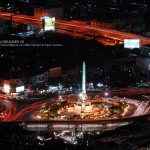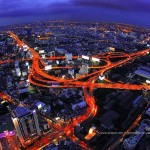Before landing to Bangkok, I would like to share history of Thailand and background of Bangkok.
Thailand Overview
Named as Siam until 1939, the Kingdom of Thailand was officially established in the mid-14th century. Thailand is situated in the centre of Southeast Asia. Thailand shares borders with the Laos People’s Democratic Republic and the Union of Myanmar to the North, the Kingdom of Cambodia and the Gulf of Thailand to the East, the Union of Myanmar and the Indian Ocean to the West, and Malaysia to the south.
The total land area in Thailand is approximately 513,120 square kilometres, which is considered the world’s 51th largest country. The number of Thai population is about 67 million people, updated as of July 2011, the world’s 20th largest country in terms of population.
The population of Thailand consists of 75 percent Thais, 14 percent Chinese, 3 percent Malays and 8 percent of minority groups, such as the Mons, Khmers and other hill tribes. The official language is Thai but English is widely spoken. The primary religion of the Thai population is Buddhism, approximately 94.6 percent. Muslims, the second largest religious group at about 4.6 percent, are mostly concentrated in the southern part of Thailand such as Narathivas, Pattani and Yani provinces. Only 0.7 percent of the total Thai population are Christian.
Thailand is divided into 77 provinces and subsequently into districts. The capital of Thailand, Bangkok, and Pattaya are considered special governed districts. Thailand has distinctive geological features.
In the Northern part, almost 70 percent of the area is mountainous with the highest point at Doi Inthanon , rising 2,565 metres above sea level. The major city is Chiang Mai, the economic, cultural and educational centre in the North. During November until the end of February, the temperature of the northern part is normally lower than other regions in Thailand.
In the Northeast, the areas are mostly high plateau and cover one third of the whole area of the country. The Mekong River is on the east which is considered as the border between Thailand and Laos. The major cities of this region are Nakhon Ratchasima, the center for land transportation in this region. Ubon Ratchathani and Nong Khai are the gateway to Laos.
In The Central region, the areas are dominantly flat plain with the Chao Phraya River running through the Gulf of Thailand. Hence, the main agricultural areas in this region are the three large basins of the Chao Phraya, Pasak, and Bang Pakong rivers. The location of Metropolitan Bangkok, the capital city, is also located at the Central region. Suphan Buri, Nakhon Pathom, Samut Prakan, and Ayutthaya are the industrial cities in response to the expansion of Bangkok.
In the southern part, it consists of the narrow Kra Isthmus in Ranong and Chumphon. This region is connecting with the Malay Peninsula and Malaysia in the south. It also separates the narrow coastal plains along the Gulf of Thailand and the Andaman Sea. The major cities are Phuket, Songkra, and Nakhon Si Thammarat. Industries include Para rubber plantations, oil palm plantations, fishing and fish processing. The weather in this region is mostly rainy, tropical and high humidity.


HISTORY OF BANGKOK OVERVIEW
Thailand was firstly established by the Sukhothai Kingdom in 1238. During the Sukhothai period, it prospered in art, culture, and trade. The Thai alphabet was firstly developed. Sukhothai was governed in the style of “the Father of the Town,” or paternal kingship, and was ruled by nine consecutive kings. The Sukhothai Kingdom lasted approximately two centuries until it was merged with the Ayutthaya Kingdom in 1438.
The Ayutthaya Kingdom was established from 1350 to 1767. During this time, the Ayutthaya kingdom was expanding its power over nearby territories. Ayutthaya completely defeated the Khmer and merged with the Sukhothai Kingdom. Unlike Sukhothai, Ayutthaya was governed in the divinity of the monarchy. The Portugal was the first country to establish a relationship and to trade with Ayutthaya. There was also trade with China, Holland, Japan, and England. The wealth gained from trade with foreign countries resulted in progress with the help of new technology in architecture, medicine, astronomy, and military affairs. Throughout 417 years, the Ayutthaya Kingdom collapsed because of internal conflict and finally the Burmese invasion in 1767. After the fall of Ayutthaya, the kingdom was still in turmoil and Ayutthaya was beyond renovation. Hence, the city was moved from Ayutthaya to Thonburi in 1767. Only after 15 years, Thonburi was collapsed because of disorder.
In 1782, King Rama I, founder of the Chakri Dynasty, began Rattanakosin Period by moving the capital from Thonburi to the new capital, named Krung Thep Maha Nakhon (Bangkok), or the City of Angels.
King Rama I modeled Bangkok after the former capital of Ayutthaya, with the Grand Palace, Front Palace and royal temples by the river, next to the royal field. Continuing outwards were the royal court of justice, royal stables and military prison. Government offices were located within the Grand Palace, while residences of nobles and then commoners spread outwards from the city centre.
Since then much of Bangkok’s history has been dominated by the constant renovation of the old temples, palaces, and monuments in the city, as in Thailand it is the divine responsibility of the king to maintain Buddhism.
In the 19th century, the British conquered Burma whereas the French took Siam’s formal vassal states, Laos and Cambodia. Due to the diplomacy of King Rama IV and V, who conceded territorial claims in exchange for independence, the two western powers accepted Siam as a buffer state between them. Thailand is the only Southeast Asian country never to have been taken over by a European power.
In the reign of King Rama IV and V, there were much development and modernization in Bangkok and Thailand. The city’s first paved street was completed and proceeded to construct new city roads, developing a railway line connect to the north of Bangkok as well creating a tramway. In addition, there was gradual increase of foreigners into Bangkok, missionaries and traders who came from many Europe and North America countries. By 1860 many traders had formed economic alliances and treaties with Bangkok.
By 1900, rural market zones in Bangkok began developing into residential districts. The Memorial Bridge was constructed in 1932 to connect Thonburi to Bangkok which was believed to promote economic growth in a period when infrastructure was developing considerably.
On 24 June 1932, Phibul Songgram, an ambitious junior army officer, and Pridi Phanomyang, a French-educated civilian and leader of the secret People’s Party, staged a bloodless coup d’etat. Since then, Thailand changed from an absolute monarchy system to a democratic power system with the king as a leader of the country. The present king is King Bhumibol Adulyadej, the ninth king of the Chakri Dynasty.
The renovation of the old temples and building of new ones have been the characteristic tradition of the Kingdom up to the present day. The history of Bangkok is depicted in all important palaces, temples, building, and monuments.


